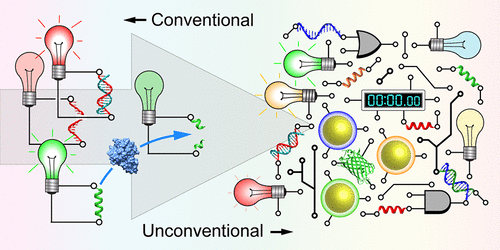当前位置:
X-MOL 学术
›
ACS Chem. Biol.
›
论文详情
Our official English website, www.x-mol.net, welcomes your feedback! (Note: you will need to create a separate account there.)
More Than a Light Switch: Engineering Unconventional Fluorescent Configurations for Biological Sensing
ACS Chemical Biology ( IF 4 ) Pub Date : 2018-02-20 00:00:00 , DOI: 10.1021/acschembio.7b01022 William J. Peveler 1, 2 , W. Russ Algar 1
ACS Chemical Biology ( IF 4 ) Pub Date : 2018-02-20 00:00:00 , DOI: 10.1021/acschembio.7b01022 William J. Peveler 1, 2 , W. Russ Algar 1
Affiliation

|
Fluorescence is a powerful and sensitive tool in biological detection, used widely for cellular imaging and in vitro molecular diagnostics. Over time, three prominent conventions have emerged in the design of fluorescent biosensors: a sensor is ideally specific for its target, only one fluorescence signal turns on or off in response to the target, and each target requires its own sensor and signal combination. These are conventions but not requirements, and sensors that break with one or more of these conventions can offer new capabilities and advantages. Here, we review “unconventional” fluorescent sensor configurations based on fluorescent dyes, proteins, and nanomaterials such as quantum dots and metal nanoclusters. These configurations include multifluorophore Förster resonance energy transfer (FRET) networks, temporal multiplexing, photonic logic, and cross-reactive arrays or “noses”. The more complex but carefully engineered biorecognition and fluorescence signaling modalities in unconventional designs are richer in information, afford greater multiplexing capacity, and are potentially better suited to the analysis of complex biological samples, interactions, processes, and diseases. We conclude with a short perspective on the future of unconventional fluorescent sensors and encourage researchers to imagine sensing beyond the metaphorical light bulb and light switch combination.
中文翻译:

不仅仅是电灯开关:用于生物传感的工程非常规荧光配置
荧光是生物检测中强大而灵敏的工具,广泛用于细胞成像和体外分子诊断。随着时间的流逝,荧光生物传感器的设计中出现了三个突出的约定:理想地,传感器专门针对其靶标,只有一个荧光信号响应于靶标才能打开或关闭,并且每个靶标都需要自己的传感器和信号组合。这些是约定,但不是要求,违反这些约定中的一项或多项的传感器可以提供新的功能和优势。在这里,我们回顾基于荧光染料,蛋白质和纳米材料(例如量子点和金属纳米团簇)的“非常规”荧光传感器配置。这些配置包括多荧光Förster共振能量转移(FRET)网络,时间复用,光子逻辑和交叉反应阵列或“鼻子”。非常规设计中更为复杂但经过精心设计的生物识别和荧光信号传递方式,其信息丰富,提供了更高的复用能力,并可能更适合于分析复杂的生物样品,相互作用,过程和疾病。我们以非常规荧光传感器的未来的短期观点作为结束,并鼓励研究人员想象比隐喻灯泡和灯开关组合超出的传感。
更新日期:2018-02-20
中文翻译:

不仅仅是电灯开关:用于生物传感的工程非常规荧光配置
荧光是生物检测中强大而灵敏的工具,广泛用于细胞成像和体外分子诊断。随着时间的流逝,荧光生物传感器的设计中出现了三个突出的约定:理想地,传感器专门针对其靶标,只有一个荧光信号响应于靶标才能打开或关闭,并且每个靶标都需要自己的传感器和信号组合。这些是约定,但不是要求,违反这些约定中的一项或多项的传感器可以提供新的功能和优势。在这里,我们回顾基于荧光染料,蛋白质和纳米材料(例如量子点和金属纳米团簇)的“非常规”荧光传感器配置。这些配置包括多荧光Förster共振能量转移(FRET)网络,时间复用,光子逻辑和交叉反应阵列或“鼻子”。非常规设计中更为复杂但经过精心设计的生物识别和荧光信号传递方式,其信息丰富,提供了更高的复用能力,并可能更适合于分析复杂的生物样品,相互作用,过程和疾病。我们以非常规荧光传感器的未来的短期观点作为结束,并鼓励研究人员想象比隐喻灯泡和灯开关组合超出的传感。



























 京公网安备 11010802027423号
京公网安备 11010802027423号